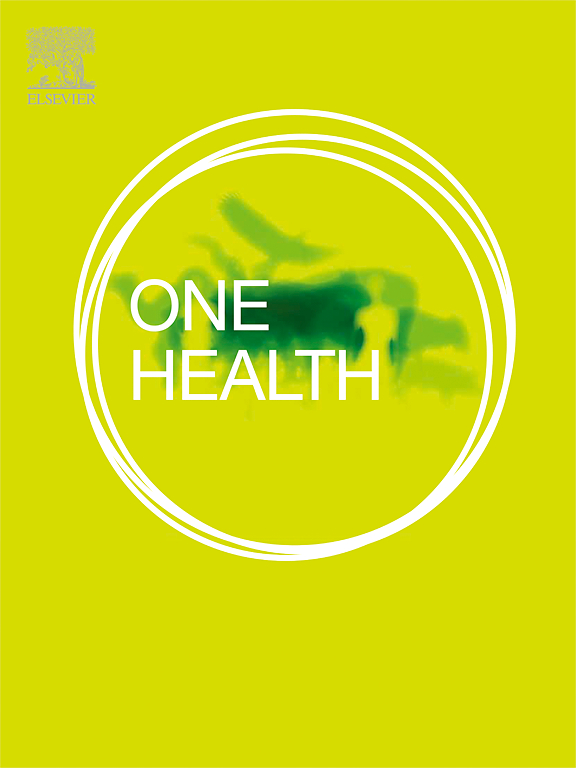气象、大气污染及其交互作用对HFRS的影响和滞后效应——以华中城市为例
IF 4.1
2区 医学
Q1 INFECTIOUS DISEASES
引用次数: 0
摘要
目的中国是世界上肾综合征出血热(HFRS)发病率最高的国家。本研究探讨气象、大气污染及其相互作用对HFRS病例的影响,旨在指导不同气象条件下的防控策略。方法收集2012-2021年湖南省每日HFRS病例、气象和大气污染物数据。通过构建分布滞后线性模型(DLNM)和贝叶斯核机回归(BKMR),综合评价气象和大气污染物混合效应对HFRS发病的影响。结果(1)DLNM结果显示,当风速(WS)为1.9 m/s时,HFRS发病风险最低(RR = 0.25);高WS组发生HFRS的风险在第21天最高(RR = 1.12)。(2) BKMR结果表明,在中低温条件下,相对湿度(RH)、二氧化硫(SO2)和臭氧(O3)的影响最大(后验包含概率(PIP) = 1.0)。(3)中、高温条件下气象因子与大气污染物的综合作用与HFRS发病率呈正相关,中、低温条件下则相反。结论气象因素和大气污染物对HFRS发病有滞后效应。气象因素和大气污染物的共同作用促进了HFRS的发病和传播。在中等和高温条件下接触其他研究因素的程度越高,患HFRS的风险就越大。因此,在中高温环境中,应重点关注HFRS,并明确预防措施。本文章由计算机程序翻译,如有差异,请以英文原文为准。
Impact and lag effects of meteorology, air pollution and their interaction on HFRS: A case study of cities in Central China
Objective
China has the highest incidence of hemorrhagic fever with renal syndrome (HFRS) worldwide. This study examines the influences of meteorology, air pollution, and their interplay on HFRS cases, aiming to guide prevention and control strategies under varying meteorological conditions.
Methods
Data on daily HFRS cases, meteorology, and air pollutants in Hunan, 2012–2021, were collected. The effects of the mixed effects of meteorological and air pollutants on the incidence of HFRS were comprehensively evaluated by constructing a distributed hysteresis linear model (DLNM) and Bayesian nuclear machine regression (BKMR).
Results
(1) The results of the DLNM revealed that when the wind speed (WS) = 1.9 m/s, HFRS had the lowest risk of onset (RR = 0.25). The risk of HFRS was highest on day 21 in the high WS group (RR = 1.12). (2) The results of the BKMR showed that, under medium- and low-temperature conditions, relative humidity (RH), sulfur dioxide (SO2), and ozone (O3) had the greatest impact (Posterior inclusion probabilities (PIP) = 1.0). (3) The combined effects of meteorological factors and atmospheric pollutants were positively correlated with the incidence of HFRS under medium and high temperature conditions, while the opposite was true for medium and low temperatures.
Conclusion
Meteorological factors and air pollutants have a lag effect on the incidence of HFRS. The combined effects of meteorological factors and air pollutants promote the pathogenesis and spread of HFRS. The higher the level of exposure to other studied factors at moderate and high temperatures, the greater the risk of HFRS. Thus, HFRS should be focused on and precautions should be specified in medium and high temperature environments.
求助全文
通过发布文献求助,成功后即可免费获取论文全文。
去求助
来源期刊

One Health
Medicine-Infectious Diseases
CiteScore
8.10
自引率
4.00%
发文量
95
审稿时长
18 weeks
期刊介绍:
One Health - a Gold Open Access journal.
The mission of One Health is to provide a platform for rapid communication of high quality scientific knowledge on inter- and intra-species pathogen transmission, bringing together leading experts in virology, bacteriology, parasitology, mycology, vectors and vector-borne diseases, tropical health, veterinary sciences, pathology, immunology, food safety, mathematical modelling, epidemiology, public health research and emergency preparedness. As a Gold Open Access journal, a fee is payable on acceptance of the paper. Please see the Guide for Authors for more information.
Submissions to the following categories are welcome:
Virology,
Bacteriology,
Parasitology,
Mycology,
Vectors and vector-borne diseases,
Co-infections and co-morbidities,
Disease spatial surveillance,
Modelling,
Tropical Health,
Discovery,
Ecosystem Health,
Public Health.
 求助内容:
求助内容: 应助结果提醒方式:
应助结果提醒方式:


